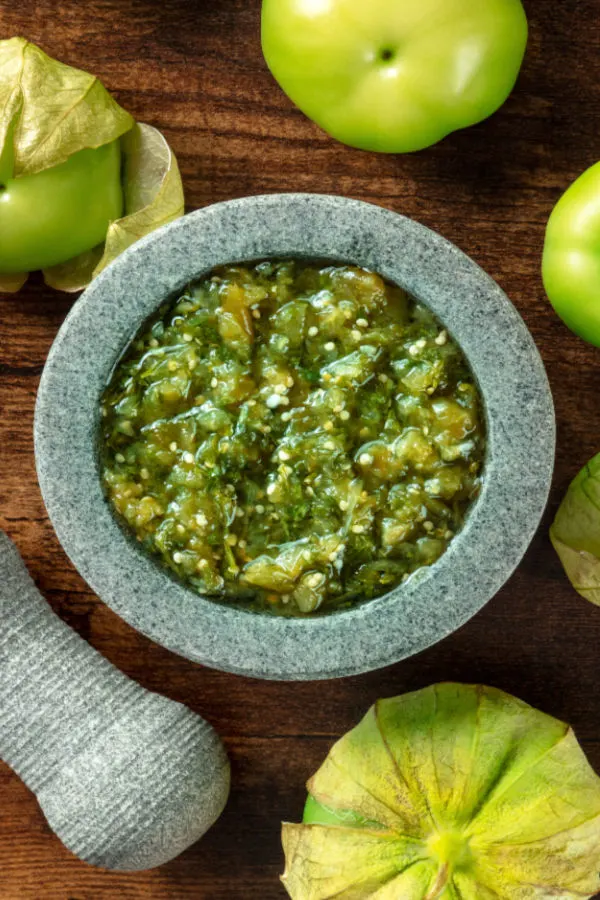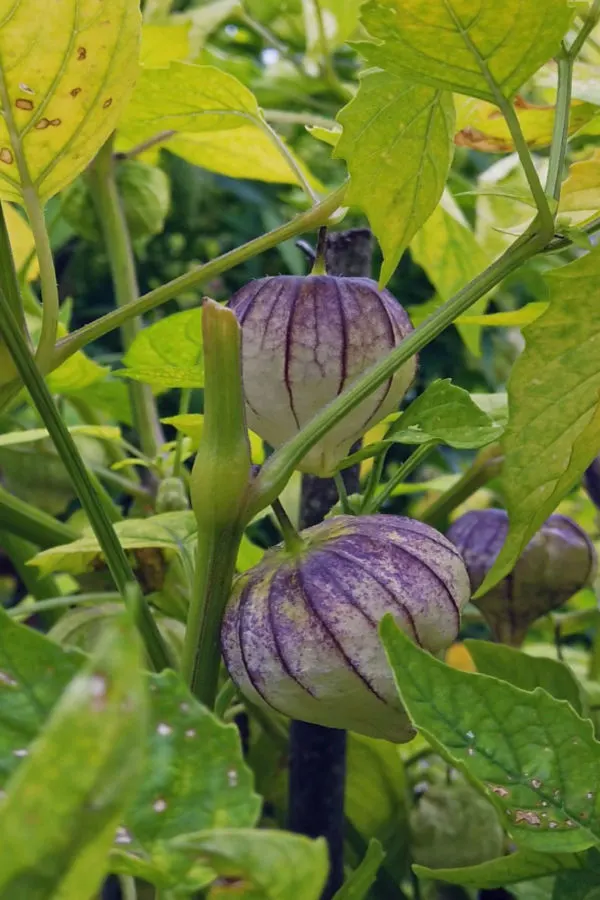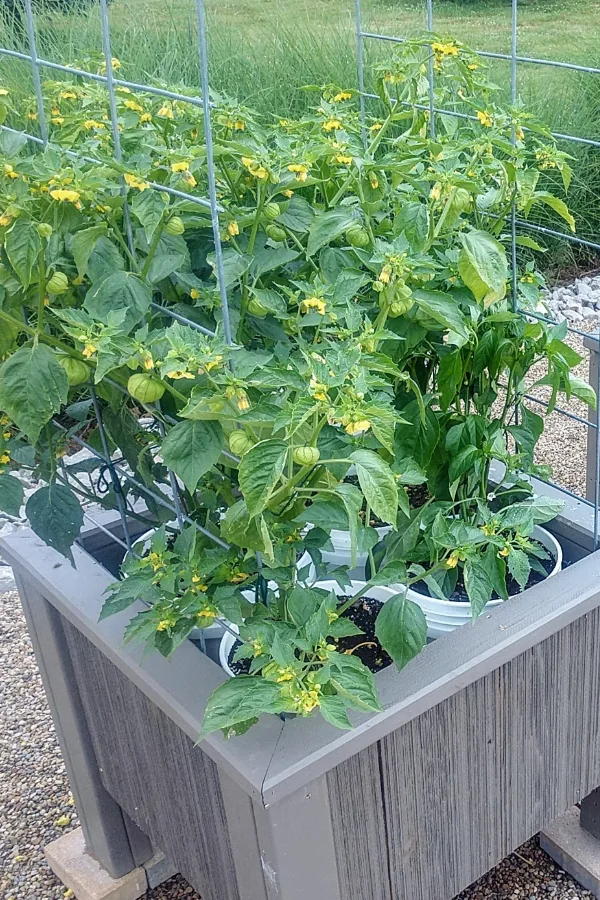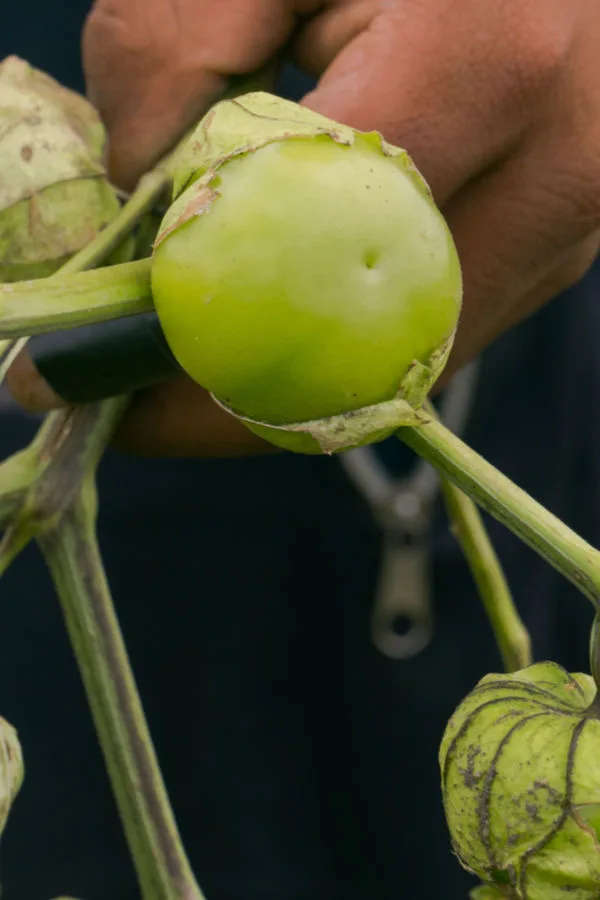Growing your own delicious crop of tomatillos is an excellent way to add interest, color and a bit of fun to your garden. But even more, it can bring a large and flavorful harvest that will fill your kitchen with delicious salsa, soups and more!
Tomatillo plants have become an increasingly popular plant in recent years for growing at home – and for good reason. The slightly tart fruit that resembles a green tomato is the key ingredient for making salsa verde, a delicious green salsa that is wondrous as a dip or for flavoring all kinds of foods.
But tomatillos worthiness in the kitchen goes far beyond just simple and amazing green salsa. The one to two inch round fruits (much like a tomato, tomatillos are technically a fruit and not a vegetable) are also great for making stews, soups and a slew of other fresh dishes.

Growing Tomatillos
So just how easy is it to grow tomatillos? Well, if you can grow tomatoes, you can grow tomatillos! Although the name tomatillo in Spanish translates to “little tomato”, it’s actually not a tomato plant at all. It is, however, a close relative.
Both tomatillos and tomatoes are members of the nightshade family. Because of their similarities, tomatillo plants grow well using many of the same methods that work to grow tomatoes successfully. Even better, just like tomatoes, they can be grown in a traditional garden, or quite easily in pots and containers.
But what makes tomatillos unique is how they grow and mature. Unlike a tomato, which starts out small and grows to size, the tomatillo plant first produces an empty papery lantern on its stem. As each tomatillo matures, it then fills out the lantern from the inside out.
When it is finally mature, the papery skin rips gently apart, revealing the green globe of a ripe tomatillo. It’s truly a fascinating process to watch, and really makes quite the conversation piece for visitors to your garden.

With that in mind, here is a look at how to grow your own big crop of tomatillos this year! We have even included a great “classic” salsa verde recipe at the end of the article as well to help turn your tomatillo harvest into amazing salsa!
Growing Tomatillos
Starting Plants Indoors
Although they are becoming more popular with each passing year, tomatillo plants can often be hard to find in local nurseries and big box stores. Because of this, growing your own from seed is the best way to make sure you have plants on hand.
There are several varieties of tomatillo plants to choose from. The classic green tomatillo is the most common, but there are several other colors and varieties including the purple tomatillo that are not only delicious, but beautiful as well. We have included affiliate seed links below for those looking to purchase seeds.
Tomatillo Seed Links
Most tomatillo plants take around 95 to 100 days to reach maturity. Because of this lengthy time, much as with tomato plants, it’s important to grow from transplants, not direct seeding. Unfortunately, in most climates, there are simply not enough growing days in a season to have plants produce from sowing directly into the soil.
The good news is that tomatillo seeds can be started indoors in exactly the same fashion as other vegetable and flower seeds. (See: What You Need To Starts Seeds Indoors).

Seeds should be planted indoors six to eight weeks before you are able to plant outdoors. To know when to start seeds, simply count back from your planting area’s last average frost date. The key to success is to have transplants 8 to 12 inches in height when the time comes to plant outdoors.
Once the soil has warmed and the threat of frost has passed, it’s time for planting! Tomatillos grow extremely well in gardens, raised beds, 5 gallon buckets or large containers. No matter where you grow them, they have the same simple requirements for success as tomato and pepper plants do.
Planting Tomatillo Plants
Tomatillo plants need fertile, loose, well draining soil to grow strong roots. When planting in a traditional garden setting, amend each planting hole with a generous amount of compost. Compost is not only full of nutrients, it will also help the roots of tomatillo plants retain valuable moisture.
A few cups of compost mixed into the soil for each plant will more than do the trick. When planting, bury the transplants deep in the soil. A good rule of thumb is to plant half of a six to twelve inch tomatillo plant underneath the soil. This allows for more roots to develop deep in the soil.
If you are planting in a container, begin by filling the pot with a high quality potting soil. Again, adding in a few cups of compost or worm castings to the potting soil can increase overall fertility and soil structure.

Last but not least, and this is vital, you will need to plant more than one tomatillo to get fruit production. Tomatillos are not self pollinating. This means at least two plants are needed to allow for cross fertilization of the blooms.
This is extremely important to remember when planting in pots or containers. Plant multiple plants in a single large pot, or at least two small pots with one plant each to ensure a viable crop.
Providing Support – Growing Tomatillos
Like tomato and pepper plants, tomatillos benefit greatly from a bit of support. The best way to give that support is with a stake, cage or trellis.
Tying up your plants helps to keep the plant’s stems and branches off the ground and out of harms way. It also allows for good air circulation around the plant’s foliage and ripening fruit. Good circulation is important for both pollinating and setting fruit, as well as helping fruit to ripen more rapidly and even.
How To Know When To Harvest – Growing Tomatillos
The fruits of tomatillos are ready to pick as soon the husk fills out and begins to split open. As your plants begin to produce, simply keep an eye on the lanterns. As they mature, you will begin to see the husk tear away from the tomatillo,. When this happens, it is time to pluck it from the plant.

The tomatillo will slip out of the husk easily. In fact, quite often, they will fall out to the ground below before you even pick them. Tomatillos can be a bit sticky on their surface when removed from the husk. This is completely normal and a quick rinse will remove the stickiness.
The key to big production and a large harvest is to keep picking the fruit as it ripens. Much like tomato, pepper and cucumber plants, tomatillos can suffer from fruit overload. If a plant becomes too full of ripening fruit, it will slow or stop producing new blooms.
It does this in order to concentrate its energy on ripening the excess fruit, so the more tomatillos you pick, the more you will get! And once your plants start producing, here is a quick, easy and delicious way to make your own homemade salsa verde!
The Perfect Salsa Verde Recipe
Ingredients
- 8 tomatillos peeled
- 3 cloves of garlic peeled
- 1 white onion diced
- 1/2 cup of cilantro
- Juice of 1/2 lime squeezed
- 3 jalapeno peppers (serrano peppers can be used as well)
- Add salt to taste ( 1/2 to 1 teaspoon)
Directions:
Roast the tomatillos and peppers on a baking sheet at 400° (F) for 12 to 15 minutes or until the tops become brown. Place the peppers and tomatillos and the rest of the ingredients in a blender. Pulse and belnd until smooth, adding salt to taste.
Then pop in the refrigerator to chill and it’s ready to serve and enjoy. Here is to growing your own great crop of tomatillos this year!
Follow Our Facebook Page For Great Gardening Tips And Advice! This Is My Garden Facebook Page
This Is My Garden is a garden website created by gardeners, for gardeners. Jim and Mary Competti have been writing gardening, DIY and recipe articles and books and speaking for over 15 years from their 46 acre Ohio farm. They publish three articles every week, 52 weeks a year. Sign up today to follow via email, or follow along!
